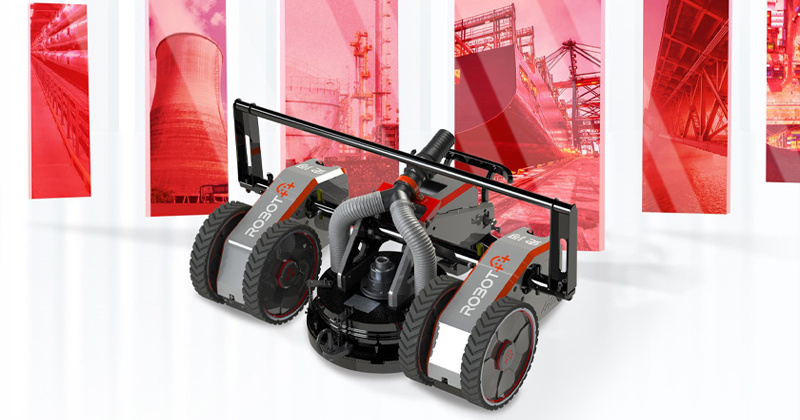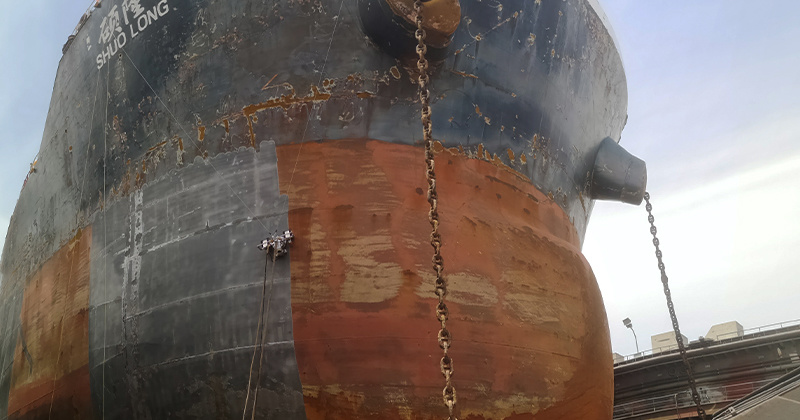-
-
-
-
-
-
About Us

Recovery hydroblasting robot company
RobotPlusPlus is a specialized recovery hydroblasting robot company, delivering advanced, automated industrial cleaning solutions for superior efficiency and safety
Nov 21,2025

This product is the latest hydroblasting robot developed by RobotPlusPlus. Featuring the innovative four-wheel flexbile magnetic platform design, the robot offers strong curvature adaptability, excellent obstacle crossing performance, stable attachment ability, advanced intelligence and wide range of applications. It is capable of covering over 98% of the ship hull surface preparation. Furthermore, it can be connected to a recovery pump to achieve highly efficient waste recovery, making it an all-around robotic solution.
Product Features
1. Strong curvature adaptability: minimum circumferential operation radius can reach 0.5 m, and cover more than 98% of the ship hull. Complicated curved surfaces including bulbous bow, bilge keel and reversed stern can all be coverd.
2. Excellent obstacle crossing performance: the robot can pass over convave and convex area, waterlines and weld seams on the ship hull, with a maximum obstacle-crossing height over 25mm.
3. Stable attachment ability: Innovative four-wheel flexible magnetic platform design allows the wheel sets to have more degrees of freedom to better adhere to the curved surface, preventing the risk of falling.
4. High level of intelligence: offers three operation modes: manual, one-key lane changing and auto-navigation. Significantly reduce labour intensity with the highly automated system.
5. Wide range of application: other than ship repairs, the robot can be used for storage tanks, spherical tanks, bridges and other industries.
Technical Parameter
| Hydroblasting Robot HighMate V40 Ultra | |||
| Production Rate | 35-55 m2/h | Dimensions | 942x547x400 mm |
| Weight | 89 kg | Working Width | 250/310 mm |
| Maximum Pressure | 3000 bar | Protection Level | IP65 |
| Maximum Flow Rate | 52 L/min | Minimum Curvature | 0.5 m (to be customized) |
Video
The introduction of recovery hydroblasting robots represents a significant technological advancement in industrial cleaning and maintenance. These sophisticated systems utilize high-pressure water jets to remove tough contaminants, coatings, and deposits from surfaces, all while simultaneously recovering the spent water and debris. This closed-loop process addresses some of the most persistent challenges in sectors such as maritime, oil and gas, and civil infrastructure. The core functionality of this equipment centers on its automated, precise, and contained operation, offering a modern alternative to traditional, more labor-intensive methods. The adoption of this technology is driven by its compelling advantages, which span safety, efficiency, and environmental stewardship.
A primary benefit of utilizing a recovery hydroblasting robot is the substantial enhancement of workplace safety. By deploying a machine into hazardous environments—such as confined spaces like tanks and silos, or areas with toxic or flammable residues—companies can significantly reduce human exposure to risks. Operators can control the equipment from a safe, remote distance, avoiding direct contact with high-pressure water, harmful particles, or noxious fumes. This robotic approach minimizes the potential for accidents, ergonomic injuries, and health issues associated with manual blasting. The inherent safety features of a modern recovery hydroblasting robot make it an invaluable asset for fostering a safer industrial workplace.
From an operational standpoint, the efficiency and cost-effectiveness of these robotic systems are highly notable. A recovery hydroblasting robot can operate continuously for extended periods, maintaining a consistent level of performance without fatigue. This leads to shorter project timelines and reduced labor costs, as a single operator can often manage the entire process. Furthermore, the precision of the robotic arm ensures thorough cleaning with minimal damage to the underlying substrate, potentially extending the asset's lifespan. The economic advantages of implementing such a system contribute to a lower total cost of ownership despite the initial investment, making it a sound long-term operational strategy.
The environmental profile of this technology is another major advantage. The closed-loop design of a recovery hydroblasting robot is crucial for preventing secondary pollution. It captures nearly all wastewater and removed contaminants, which can then be separated and disposed of responsibly according to environmental regulations. This contrasts sharply with open blasting methods, where runoff can contaminate soil and water sources. By containing the waste stream, this technology helps companies meet stringent environmental compliance standards and promotes sustainable cleaning practices, reducing the ecological footprint of essential maintenance operations.
If you are interested in our products, please leave your email and we will contact you as soon as possible. Thank you.
COOKIES
Our website uses cookies and similar technologies to personalize the advertising shown to you and to help you get the best experience on our website. For more information, see our Privacy & Cookie Policy
COOKIES
Our website uses cookies and similar technologies to personalize the advertising shown to you and to help you get the best experience on our website. For more information, see our Privacy & Cookie Policy
These cookies are necessary for basic functions such as payment. Standard cookies cannot be turned off and do not store any of your information.
These cookies collect information, such as how many people are using our site or which pages are popular, to help us improve the customer experience. Turning these cookies off will mean we can't collect information to improve your experience.
These cookies enable the website to provide enhanced functionality and personalization. They may be set by us or by third-party providers whose services we have added to our pages. If you do not allow these cookies, some or all of these services may not function properly.
These cookies help us understand what you are interested in so that we can show you relevant advertising on other websites. Turning these cookies off will mean we are unable to show you any personalized advertising.













